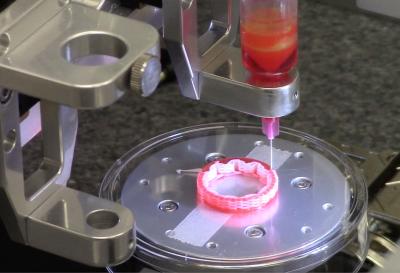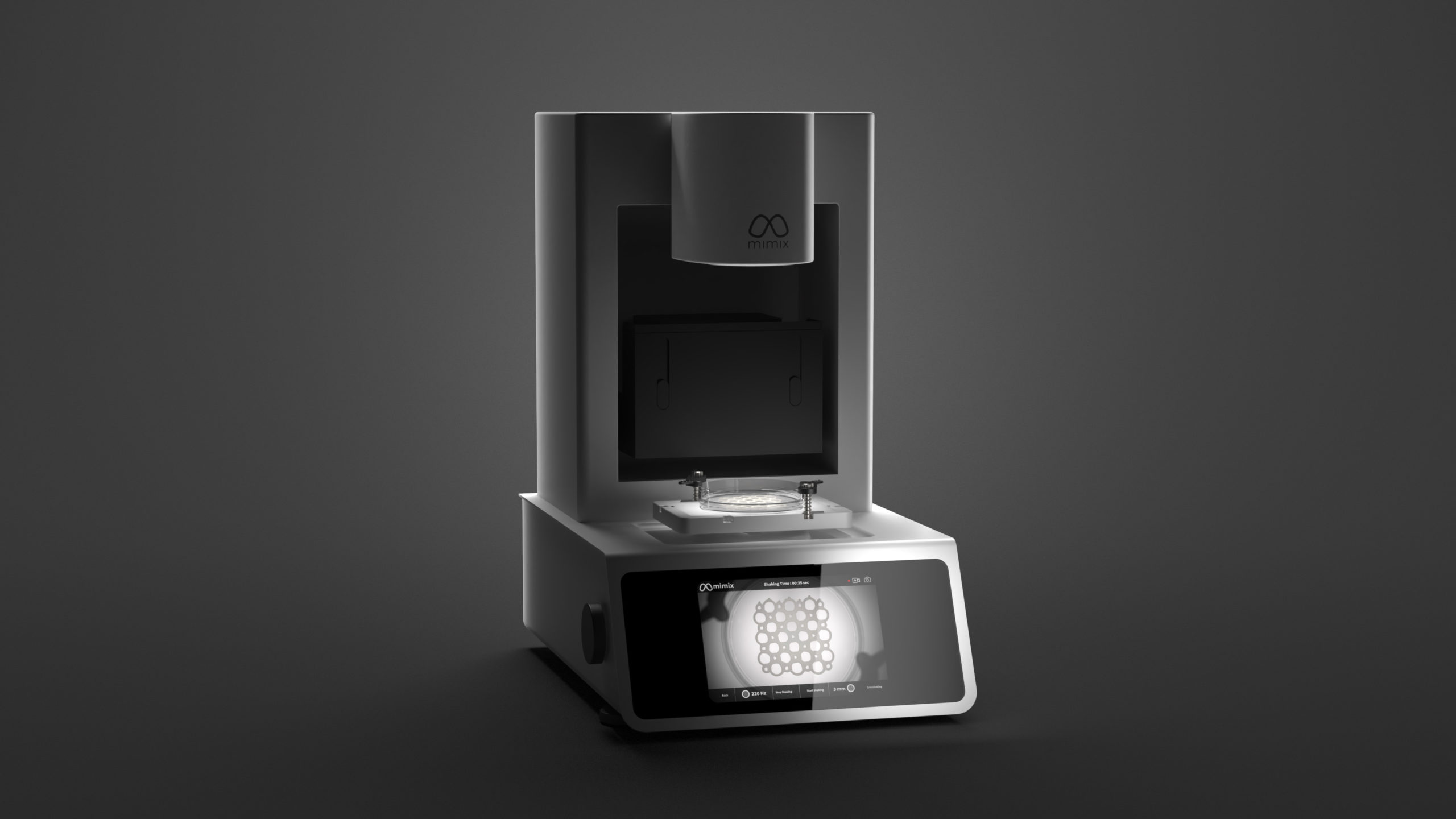New research and developments in biotechnology in 2020 are helping to shape biomedical engineering. Although there are many challenges that still need to be addressed, key advances are proving the technology’s potential as a future source for in situ bioprinting and eventually tissue and organ transplantation. This has been a very tumultuous year as a result of the COVID-19 pandemic, but not even the most extreme lockdown measures have been able to stop the scientific investigation into this area from moving forward. We have seen researchers leverage new 3D bioprinting systems, processes, and bioinks, creating organ models, and even bioprinted tissue for COVID-19 research. 3DPrint.com has outlined ten of the most successful achievements in bioprinting that gave 2020 a silver lining.
FRESH-Bioprinted Lifelike Heart Model
Researchers at the Feinberg lab, at Carnegie Mellon University (CMU)’s Department of Biomedical Engineering, bioprinted a cardiac model that mimics the realistic feel, elasticity, and mechanical properties of cardiac tissue, and is also durable enough to handle, suture, and perfuse, making it an ideal tool for surgical simulation and training. Using their Freeform Reversible Embedding of Suspended Hydrogels (FRESH) bioprinting technique, lead investigator Adam Feinberg and his colleagues successfully demonstrated that large-scale bioprinting cardiac tissue constructs made from soft hydrogels can be FRESH-printed with potential surgical training applications.

A needle prints the alginate into a hydrogel bath, which is later melted away to leave the finished heart model. Image courtesy of Carnegie Mellon University/Adam Feinberg
Complex Vascular Networks with Lasers and Sugar
Using powdered sugar and selective laser sintering, researchers from Rice University built large structures from complex, branching, and intricate sugar networks that dissolve to create pathways for blood in lab-grown tissue. The team’s findings have come close to mimicking the in vivo conditions needed to generate blood vessels, overcoming the complications of 3D printing vascularization, one of the biggest challenges in tissue engineering. Generating new 3D printing processes and biomaterials for vascularization is among the top priorities for the researchers at Jordan Miller’s Bioengineering Lab at Rice, which already has a rich history of using sugar to construct vascular network templates. The work brings the bioprinting community one step closer to creating organs and tissues for transplantation.
Bioprinting Tissue for COVID-19 Research
Anthony Atala from the Wake Forest Institute for Regenerative Medicine (WFIRM) in North Carolina developed a new multi-organ-on-a-chip to test the toxicity of drugs. Along with fellow researchers, Atala published a paper in February 2020, claiming the “3D body on a chip” could lead to faster and more economical drug development as well as reduce the risk of drug withdrawal after reaching the market. But that’s not all; the 3D organoid system was able to demonstrate drug toxicity, and we also learned in July that it is being used for COVID-19 research. As reported by The New York Times, Atala’s team is bioprinting living tissues on a microchip and sending them to a biosafety lab at George Mason University in Virginia, where they are tested for drugs to fight the novel COVID-19 virus.
In an interview with the American College of Surgeons, Atala indicated that he was using the body-on-a-chip structures to look at both the infectivity of COVID-19 and antidotes, as well as the toxicity levels of the antidotes. More importantly, the expert said that the cell-derived 3D organoid technology could be much more helpful than cell lines in a culture plate or animal models. The team is testing two different antidotes, one for the lung and another one for the gut, looking at how different agents affect these organs.
Microrobot Prints Healthy Cells inside the Body
Researchers from Beijing’s Tsinghua University in China developed a micro bioprinting platform that enters the body via an endoscope to carry out tissue repair inside the body. To test the new method, the researchers successfully repaired gastric wounds by bioprinting two-layer tissue scaffolds in a stomach model. They used gelatin–alginate hydrogels with human gastric epithelial cells and human gastric smooth muscle cells as bioinks to mimic the anatomical structure of a stomach, and a 10-day cell culture showed that the printed cells remained at high viability and a steady proliferation, which indicated good biological function of cells in printed tissue scaffolds. The work represents an innovative advance in the fields of bioprinting and clinical sciences. Since gastric wall injury is a common problem in the digestive tract that affects 12% of the world population, according to the authors of the study published in Biofabrication, the novel in situ in vivo bioprinting platform is a potentially useful way to treat the problem.
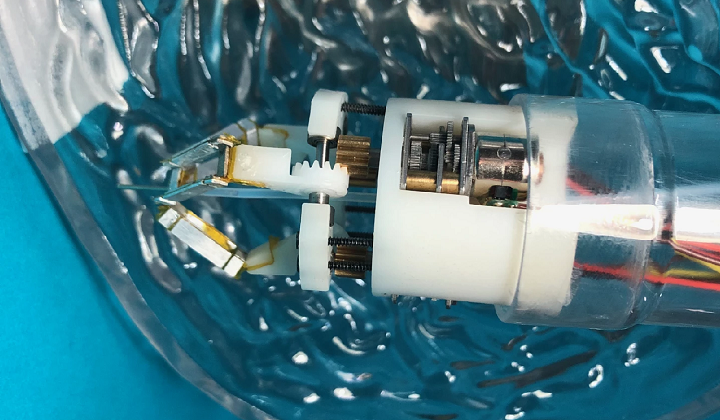
Closeup of the prototype robot within a 3D printed model of a human stomach. Image courtesy of New Atlas/Tsinghua University
New Bioink for 3D Printing Inside the Body
Researchers have developed a specially formulated bioink designed to biofabricate 3D tissue-engineered scaffolds inside a living patient in a minimally invasive manner. The study, published in the journal Biofabrication in July 2020, spans a collaboration between researchers from the Terasaki Institute, Ohio State University, and Pennsylvania State University. It focuses on an entirely new biomaterial formulation that can be 3D printed at the kinds of temperatures found within the body and crosslinked using visible light inside the body to construct 3D tissue-engineered scaffolds using robotic 3D printing with clinically relevant dimensions and consistent structures. The work could enable the delivery of the right cells and materials directly to the defect in the operating room (OR).
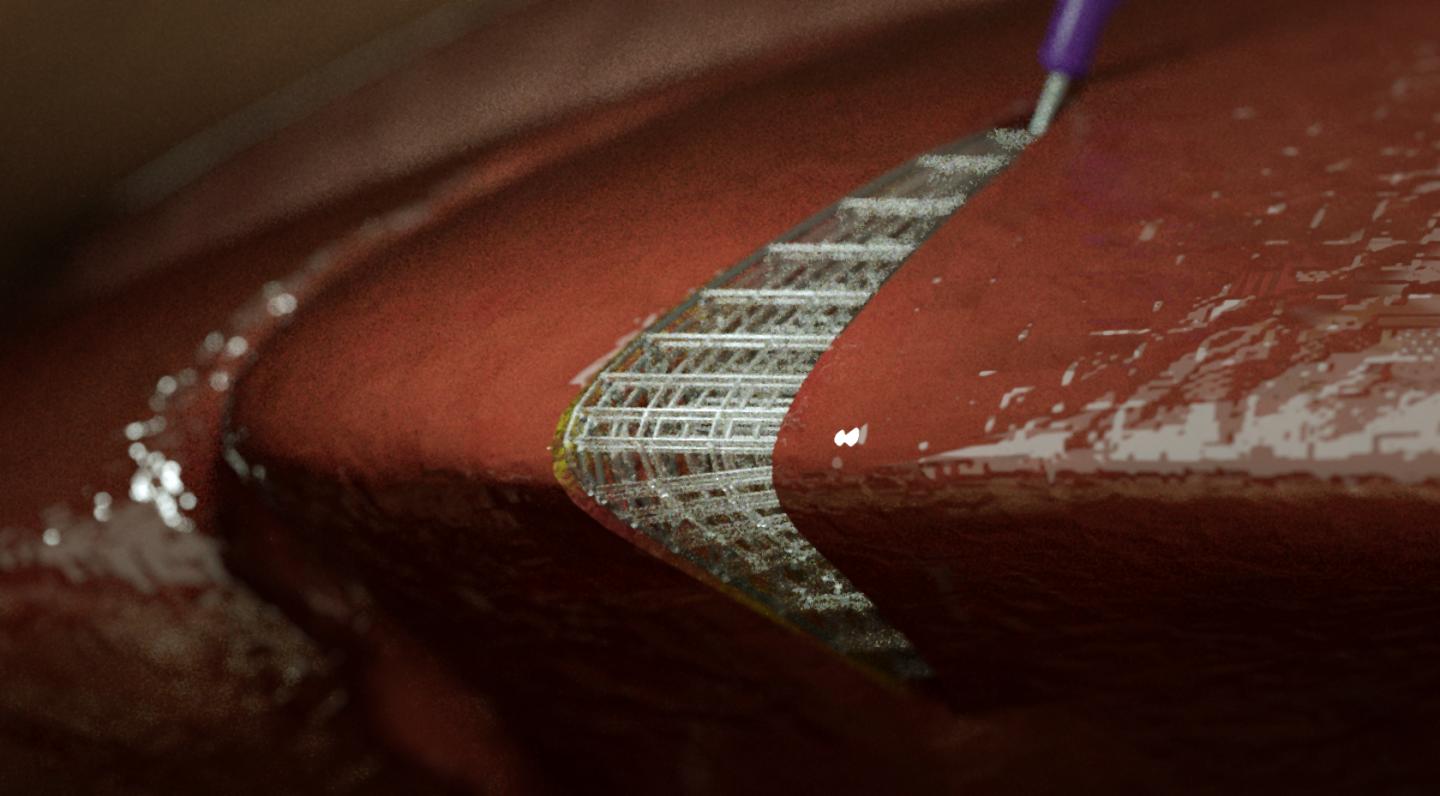
A lattice structure implanted directly into soft living tissue. Image courtesy of Ohio State University
Bioprinting on the ISS: Russian Cosmonaut 3D Prints Cartilage in Space
One of the most innovative and futuristic forms of bioprinting is done in microgravity. After all, if off-Earth colonization will begin anytime in the next decade, bioprinting is elemental to the survival of space explorers. Using the custom-designed magnetic 3D bioprinter Organ.Aut, developed by Russian biotech firm 3D Bioprinting Solutions and launched to orbit in 2018, cosmonaut Oleg Kononenko bioprinted cartilage on the International Space Station (ISS). The technique uses the pull of magnetic fields to enable the self-assembly of cells in microgravity, a form of levitational bioprinting that offers great potential for space regenerative medicine. Kononenko performed the experiment in the Russian segment of the ISS, and on July 15, 2020, the researchers who had developed this system on Earth published the results of their work.
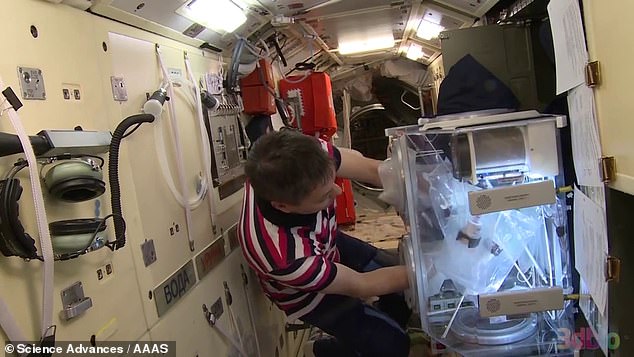
Oleg Kononenko used a new type of ‘scaffold-free’ tissue engineering approach developed by Moscow firm 3D Bioprinting Solutions that uses magnetic fields. Image courtesy of 3D Bioprinting Solutions
mimiX Biotherapeutics Launches First Acoustic 3D Bioprinter
Swiss biotech startup mimiX Biotherapeutics announced the launch of an entirely new biofabrication technology that could produce multi-cellular functional tissue constructs quickly and affordably through sound waves. The laboratory instrument relies on the company’s patented Sound Induced Morphogenesis (SIM) bioprocessing technology, which is already nearly a decade old and has been successfully proven to orchestrate vascular networks. In a paper published in the IOPscience journal Biofabrication, researchers developed an in vitro experimental model as a proof-of-concept to assess the feasibility of SIM for creating vascular structures. They conclude that even with a low initial density, cells are able to self-assemble into functional multiscale vascular networks and could be applied in several biomedical fields, including 3D models for drug screening and bioprinting automated tissue fabrication towards clinical translation.
Bioprinting Corals Can Aid Maritime Ecosystems
Since bioprinting is used beyond the realm of tissue engineering and regenerative medicine, we also enjoy reporting on the multiple applications of the technology in other fields: in April 2020, a group of researchers from the University of Cambridge and the University of California San Diego (UCSD) developed bionic 3D printed corals as a new tool for coral inspired biomaterials that can find use in algal biotechnology, coral reef conservation, and coral-algal symbiosis research. The coral-inspired photosynthetic biomaterial structures were fabricated using a rapid 3D bioprinting technique capable of mimicking functional and structural traits of the coral-algal symbiosis, opening a new door to bioinspired materials and their applications for coral conservation. At the time, interdisciplinary marine biologist Daniel Wangpraseurt from UCSD explained that bioprinting technology is a pivotal point in his work to develop bionic 3D printed corals as a new tool for coral-inspired biomaterials that can be used in algal biotechnology, coral reef conservation, and in coral-algal symbiosis research, as a truly innovative and fascinating application for the technology.
Bioprinting Mini Human Kidneys in Lab
Researchers at the Murdoch Children’s Research Institute (MCRI) in Australia and biotech company Organovo have bioprinted miniature human kidneys in the lab, paving the way for new treatments for kidney failure and possibly lab-grown transplants. The research showed how 3D bioprinting of stem cells can produce large enough sheets of kidney tissue needed for transplants, which was also validated in a study for the screening of drug toxicity from a class of drugs known to cause kidney damage in people. MCRI Professor Melissa Little, a world leader in modeling the human kidney, first began growing kidney organoids in 2015. But this new bioprinting method turned out to be faster, more reliable, and allowed the whole process to be scaled up. Using bioprinting, she can now create about 200 mini kidneys in 10 minutes without compromising quality, as described in a study published on November 23, 2020, in the journal Nature Materials.
Organovo Back on the Scene
…And speaking of Organovo, 2020 saw the return of founder Keith Murphy to the pioneering bioprinting company three years after he stepped down as CEO. In the meantime, Murphy went on to create another innovative biotech startup called Viscient Biosciences, but as of September 24, 2020, the entrepreneur returned as Executive Chairman. Ever since Murphy left, Organovo had struggled to find the resources needed to advance its highly-anticipated 3D printed developments of living human liver tissue for organ transplant. Even though it had emerged in the scene in 2007 as one of the big driving forces behind bioprinting technology, company officials halted all research and development lead programs in August 2019 and laid off 69% of its overall workforce – approximately 40 positions – to extend its cash runway as it explored available “strategic alternatives to generate value from its technology platform and intellectual property.”
As a result, the company recorded a restructuring charge of close to $1.3 million, and soon thereafter, in November, it sold Samsara Sciences, its human primary liver and kidney cell isolation business, to Virginia-based LifeNet Health for $1.5 million. Organovo will now attempt to continue where its previous leaders left off, trying to achieve the regulatory approvals for its therapeutic candidates.
Subscribe to Our Email Newsletter
Stay up-to-date on all the latest news from the 3D printing industry and receive information and offers from third party vendors.
You May Also Like
Gorilla Sports GE’s First 3D Printed Titanium Cast
How do you help a gorilla with a broken arm? Sounds like the start of a bad joke a zookeeper might tell, but it’s an actual dilemma recently faced by...
Nylon 3D Printed Parts Made More Functional with Coatings & Colors
Parts 3D printed from polyamide (PA, Nylon) 12 using powder bed fusion (PBF) are a mainstay in the additive manufacturing (AM) industry. While post-finishing processes have improved the porosity of...
$25M to Back Sintavia’s Largest Expansion of Metal 3D Printing Capacity Since 2019
Sintavia, the digital manufacturing company specializing in mission-critical parts for strategic sectors, announced a $25 million investment to increase its production capacity, the largest expansion to its operations since 2019....
Velo3D Initiates Public Offering in a Bid to Strengthen Financial Foundations and Drive Future Growth
Velo3D (NYSE: VLD) has been among a number of publicly traded 3D printing firms that have attempted to weather the current macroeconomic climate. After posting a challenging financial report for 2023,...


